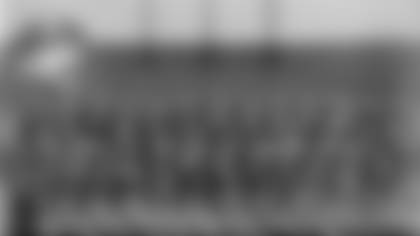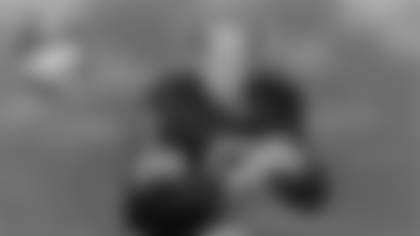Ed Bell (1949)
Kevin from Wichita Falls, TX
My granddad was "Big Ed" Neal, who played for the Packers from 1945-51. I would like to know more about his time with Green Bay. Any stories you may be aware of?
Timely question. When I think of Ed Neal, I think of Packers-Bears and their bloodbaths of that era.
For those who aren't familiar with your grandfather, he stood 6-foot-4, weighed 287 pounds, if not more, and played both center on offense and middle guard on defense. During the offseason, he was a blacksmith by trade.
Based on what other players from his era have told me, Ed was no doubt one of the most colorful players in Packers history. I interviewed Ed only once for a story I wrote for the 1977 Packers Yearbook and it was one of the more enjoyable interviews of my career.
Ed's battles with Pro Football Hall of Famer "Bulldog" Turner of the Bears were legendary.
Here's what Ed told me about those clashes for that 1977 story titled, "The Packers … A Gold Mine of Lore, Trivia and Tradition."
"I'd say it was about 1945 and right out of the box, it was the Packers and Bears. I broke (Turner's) nose three times and he broke mine twice. Then when we went down to Wrigley Field, I broke his nose twice more and he just broke mine once. On top of that, I busted his helmet five times. That's when they were just coming out with those plastic helmets and it wasn't a big thing to bust one. I'd just hit him with a forearm on top of the head and it would bust in two pieces. After that, when he'd come to Green Bay, he'd bring two or three helmets along. That was the meanest man I ever played against. We had to have a pact after that year and kind of call it off."
When I interviewed Turner in 1996 for the book, "Mudbaths & Bloodbaths: The Inside Story of the Bears-Packers Rivalry," he confirmed the stories.
"He'd hit me in the face with his forearm," said Turner, when asked about the broken noses. "He'd come right off the ground and hit me in the nose when I started to deliver the ball." As for the broken helmets, Turner said, "When I'd duck my head, he'd hit me on the top of the head and crack those helmets. I used to take two or three helmets with me when I was going to play against Green Bay."
Despite what was listed on the roster, Turner also said Neal was a 300-pounder when they were rarities. "We played in an all-star game out in California and we were on the same team," said Turner. "I put him on the scale out there and he weighed over 300 pounds and he was just hard as a rock. There wasn't any fat on him. He was just a big man."
Here's what some other players have told me about your grandpa.
Ken Keuper, a teammate from 1945-47: "His forearms, his shoulders, his biceps. They were huge."
Rebel Steiner, a teammate in 1950 and '51: "He could tell jokes for hours and he laughed at all of them. He laughed more than anybody else."
Tobin Rote, also a teammate in 1950-51: "He was my center. He was tough and he was strong. That's one guy old Bulldog Turner was afraid of, but they were good buddies off the field. They were both from Texas. Ed was a giant of a guy and strong as a bull. He wore shin-pads on his forearms and his forearms were like a big ham hock. I saw him break a beer bottle over his forearm. He'd just flex a muscle on his forearm and wing a bottle right into it, and it would just shatter. His problem was when we went on road trips, he'd always try to slip out and buy a little bottle of whiskey. He was a whiskey drinker, rather than a beer drinker like everybody else. (Gene) Ronzani would catch him every time it seemed like. He'd just take it away from him and ream him out. I'm sure Ed would go right back and get another one."
Joe Ethridge, a teammate in 1949 when the Packers trained and lived at Rockwood Lodge, along the bay shore near Dyckesville, north of Green Bay: "We had a real character who played center, big Ed Neal. He'd bring his boat up there. He'd trailer it, like a bass boat or something. He brought his guns and things. I went hunting around the lodge for grouse or squirrels or whatever they had up there."
Herm Rohrig, a teammate for all seven years in Green Bay and later an NFL official: "Over 300 pounds. He played right on the nose. He was as strong a man as I've ever been around." Rohrig also said Neal used to take kids fishing in the bay when the Packers trained and lived at Rockwood Lodge. "He loved kids," said Rohrig.
Ann from Edmonds, WA
My grandfather's name was Raymond McLean. He was born in Detroit around 1895 and died in 1967 when I was a year old. Family members speculate as to whether he played for the Packers in 1921. Can you help me confirm this?
Sorry, but no, that was not your grandfather. In fact, no Raymond McLean played for the Packers despite what has appeared in record books. Scooter McLean coached the Packers in 1958 and his first name was Raymond, but he played for the Chicago Bears in the 1940s.
"The Official National Football League Football Encyclopedia" by Roger Treat was published in 1952 and was the first encyclopedia of pro football. It listed a Raymond McLean, No College, playing for the Packers in 1921. In 1965, the Packers' annual press book included an all-time roster for the first time and Ray McLean, No College, 1921 was on the list.
Both were in error. So was "Total Football: The Official Encyclopedia of the National Football League," when it was published in 1997 and included Ray McLean in its all-time "Player Register." However, "Total Football" listed some additional information that was correct. It noted the player's nickname was "Toody," that he had gone to high school at Green Bay West and played in three games for the Packers in 1921. It also noted he was born Sept. 13, 1897, and died in Detroit on Nov. 9, 1967. That was incorrect.
The player's real name was Orlo Wylie McLean, better known as "Toody," also spelled "Tudy" in the 1916 West High yearbook. "Toody" was the same year in school as Curly Lambeau and started at fullback when West beat East, 6-0, in 1915. In 1916, Lambeau led East to victory over West for the first time in eight years by a 7-6 score, and Lambeau and McLean scored the game's only touchdowns.
"… McLean for West high played a splendid game, gaining consistently and tackling hard," the Green Bay Press-Gazette noted in its game story. "He broke his arm early in the game, but did not leave the field."
Orlo "Toody" McLean's tombstone in Wood National Cemetery in Milwaukee shows May 11, 1967, as his date of death. The United States Social Security Index lists Townsend, Wis., as his last place of residence, although I've read where he died in Milwaukee.
There are other early Packers players who have been misidentified, and there are some meticulous researchers working on getting this stuff right. David Neft, who has edited several football encyclopedias, and Steve Jubyna, who has done work for a website about the oldest living pro football players, are two that I exchange information with and try to assist.
Bill from Piedmont, SC
Why does the Packers' all-time roster only go back to 1921, not 1919?
As "Toody's" grandson, I understand why you think it might be more fitting to also include players from our first two seasons. The all-time roster in our media guide reflects players who played in NFL games. I think that's how it should be for the sake of maintaining accurate records of league play. But I agree that we should consider including a separate list of the players from our first two seasons when the Packers were a semipro team. If not for them, there would be no Packers.
In fact, Brent Hensel, our curator, and I talked this week about what else could be done in the Packers Hall of Fame in terms of telling our history as we prepare to celebrate our 100th anniversary. One of the things we discussed was a display recognizing the original 1919 Packers.
As you may know, "Toody" McLean played in all 11 games in 1919 and started six: four at quarterback and two at fullback. In 1920, he played in eight games. He also played in two non-league games in 1921 before appearing in three of the Packers' first four games in the American Professional Football Association.
Chris from Tampa, FL
My grandfather was Ed Bell. He played for the Packers from 1947-49. I was wondering if you had anything I may not have seen before. Anything you can pass along would be greatly appreciated.
He played in 35 of 36 games during those three years as a reserve tackle and guard after playing one year with the Miami Seahawks in the All-America Football Conference. Teammates called your grandfather "Bert" because the NFL commissioner at the time was Bert Bell. Following the 1949 season, your grandfather opened Bell's Juvenile Shop, an infant clothing store in Chicago, and announced his retirement.
Don't know if this was a family secret, but on the train heading for the season opener in 1948, Bell announced to his teammates, "Please, everybody, offer a moment of silent prayer for Bert. My girl wrote and said she's going to get married in three weeks." Two years later, your grandfather married Eloise Schneider in Chicago and Art Daley of the Press-Gazette, who covered the Packers at the time, was happy to report in his Sports Cocktails column that Bell had "finally discovered the right one."
I'm assuming you are proof of that.
Dave from Phoenix, AZ
I have an uncle, Jack Wilson, who signed a contract to play briefly with the Packers in 1943. I believe he was on the practice squad only and then was drafted into the Army in 1944. He was a big imposing man, 6-5, 285, and had a well-chronicled wrestling career. He was born on June 17, 1918, in Gillett, Wis. Is there anything more you can tell me about his time with Curly and the Pack?
My wife is from Gillett and we're members of the Gillett Historical Society so your question intrigues me. But I can't find Jack Wilson's name on any preseason rosters or in a newspaper search of the Press-Gazette in the early 1940s. There were no practice squads per se then, but Lambeau was known to stash players from the area and use them in practice in case of an emergency.
I found a reference to a Jack Wilson, who played semipro football in Milwaukee in 1951. I also found reference to a Jack Wilson, an oversized left tackle at Ohio State in the late 1940s who played next to left guard Ray DiPierro, who went on to play for the Packers in 1950-51. But the dots don't seem to connect and the timeframes differ.
Do you have a copy of a signed Packers contract? Let me know if you find anything more.
Richard from Santa Maria, CA
There is a 95-year old gentleman in Santa Maria who tells us his father played for the Packers in 1919. The player's last name was Dumouchelle. Can you find any information on him?
No Dumouchelle played for the Packers in 1919 nor at any other time.















